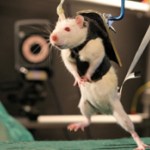Paralysis
Pioneering research being conducted by Dr. Gregoire Courtine (Swiss Federal Institute of Technology - Lausanne) may enable paralyzed humans to walk again someday. Through his collaborative research with a lab in Beijing China, he has developed a wireless brain implant that detects signals in the brain and then sends these signals to electrodes implanted in the lower spine (below the injured region) of the animals. This technology allows the brain signals to bypass the spinal cord injury.
Dr. Courtine is beginning trials in paralyzed humans using a simpler model of his new…
Image from www.pufferfish.net
It should be noted that the theory of dolphins getting "high" off puffer fish is highly controversial as others have mentioned that tetrodotoxin, the neurotoxin released from puffer fish, is famous for causing paralysis making it more of a poison as opposed to a good time. It is reportedly more potent than cyanide. In fact, a study published in 1990 reported tetrodotoxin as the cause of death of two Atlantic dolphins found dead in a lagoon (Hokama et al., J Clin Lab Anim. 1990).
So what exactly are those dolphins doing with the puffer fish in the BBC…
Jasper is just one of the injured dogs that this research team has been able to help walk following an injection of nasal cells:
Scientists have been able to restore locomotion in paralyzed rats using a combination of nerve stimulation and engaging the mind by having the rats complete simple tasks (like obtaining treats). In the newly published research, Dr. Grégroire Courtine (University of Zurich and the Swiss Federal Institute of Technology) and his team created a rat model of spinal cord injury. After designing a support jacket for the rats, they used a combination of neurotransmitters and electrical impulses to excite the nerves to produce involuntary stepping actions, which alone did not activate…

